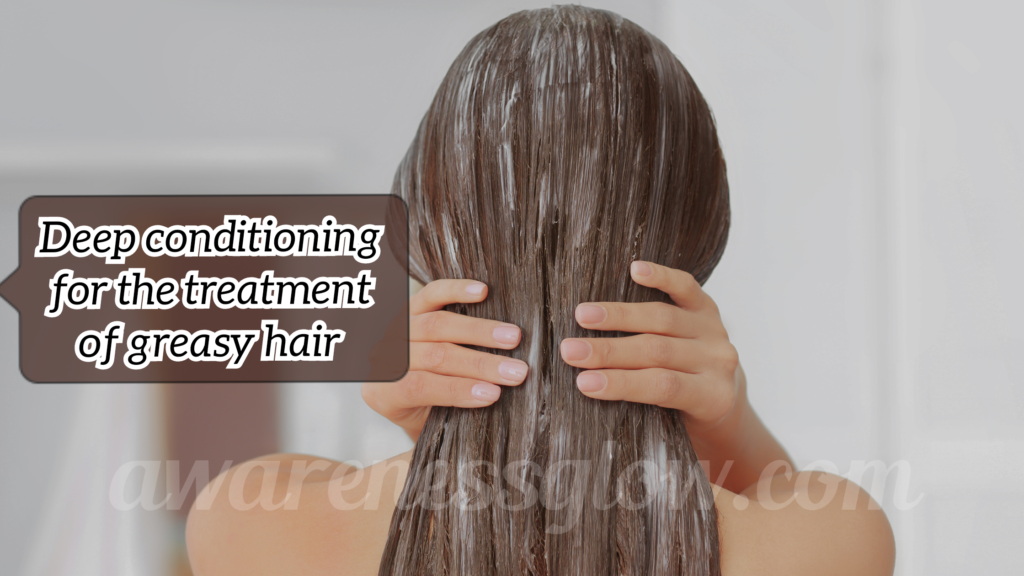
Deep conditioning for the treatment of greasy hair
Introduction;
A deep conditioning hair mask is an intense treatment meant to nourish, hydrate, and repair hair from the inside. Apply the mask to clean, damp hair, paying particular attention to the mid-lengths and ends. Leave it on for ten to thirty minutes, or as advised; then, rinse thoroughly. For the best results, use it weekly or as needed to keep healthy, shining hair.
How should one apply a deep-conditioning hair mask?
Select the appropriate hair mask:
Choose a deep conditioning mask appropriate for your hair type—dry, oily, curly, or color-treated.Look for products that target your particular hair issues, including proteins for damaged hair or moisturizing agents for dry hair.
Often repeat:
- Use the deep conditioning mask once a week or as needed based on the state of your hair.
- Over time, regular use will help your hair look, feel, and grow healthier.
- These directions will help you to maximize the advantages of your deep conditioning hair mask and maintain the best possible condition of your hair.
- Using a towel, gently squeeze out extra water from your hair.
- Hair should be damp but not soaking wet to ensure the mask can stick correctly.
Should one condition their oily hair with conditioners?
Managing Oily Hair:
When the scalp generates too much sebum—the natural oil that maintains scalp moisture—oily hair results; although sebum is necessary for preserving healthy hair, an overproduction can produce greasy, heavy-feeling, lifeless hair. Many people with oily hair are tempted to forego conditioner entirely because they believe it will aggravate their condition. That is not always the best strategy, though.
Selecting the Correct Conditioner
Finding the correct product will help you condition oily hair without making it greasier.
Following these guidelines will help:
- Conditioner should be applied mainly to the ends of your hair, where it is most needed. Usually drier and more prone to damage, the ends are where oil production is concentrated from the roots. Steer clear of the running conditioner straight on your scalp.
- Search for lightweight conditioners with “oil-free,” “for oily hair,” or “lightweight” labels. These products are meant to hydrate your hair without weighing it down or leaving a heavy residue behind.
- Clearing conditioners help eliminate extra oil and product buildup without stripping hair of required moisture. They could be a good choice if regular conditioners make hair seem weighed down.
Can I put oil on the following deep conditioning?
Using oil following deep conditioning has certain advantages.
After deep conditioning, applying oil can have several advantages—mainly if your hair is prone to dryness or frizz. Here’s how oil might improve the outcomes of your deep conditioning treatment:
Oils can naturally give your hair a gloss, enhancing its appearance and vitality.Following deep conditioning, your hair is bursting with moisture and nutrients. Applying oil locks in this moisture, preventing its evaporation and extending your hair’s hydration lifetime.Deeply condition your hair, and then carefully rinse it to eliminate all product residue.
While applying oil following deep conditioning can be helpful, it is not always necessary. If your hair is naturally fine or oily, adding more oil could weigh it down or turn it greasy. Under such circumstances, you should use a lightweight leave-in conditioner instead of petroleum or skip both.
How often ought I to treat my hair?
Elements affecting the frequency of conditioning
Type of Hair:
- Texture Curly or kinky hair is the most prone to dryness. Every other day or daily conditioning can help maintain manageable and hydrated hair.
- Straight hair often gets oily faster since the natural oils can readily descend the hair shaft. Condensing two to three times a week is usually enough if your hair is straight.
- Wavy hair is more likely to frizz and dry out. Conditioning every two to three days will help retain moisture without depressing the waves.
Deep conditioning calls for which oil?
Coconut Oil
This is specifically for dry, damaged, and frizzy hair.
Among the most often used and successful deep conditioning oils is coconut oil. Rich in fatty acids, especially lauric acid, coconut oil nourishes and intensely moistens deep into the hair shaft. It lessens protein loss, strengthens hair, and makes it less likely to break. Furthermore, the antibacterial qualities of coconut oil help improve the scalp by lowering dandruff and scalp irritation.
Use warm coconut oil, paying particular attention to your hair’s ends and dry sections. For a more intense treatment, leave it on for at least half an hour or overnight, and then gently shampoo it out.
Oil from avocado
Ideal for dry, brittle, damaged hair
Avocado oil is high in vitamins A, D, and E, along with proteins and good fats that nourish and strengthen hair. It helps restore the hair shaft and stop breakage for brittle or damaged hair. Avocado oil also boasts a high smoke point for those regularly using heat-styling tools.Apply avocado oil to your hair, mainly to damaged sections and the ends. Leave it on for thirty to sixty minutes, then gently shampoo it.
- Your hair type and particular needs will determine which oil you should use for deep conditioning. Whether your hair is frizz, damaged, or dry, an oil will help it regain health and vitality.
- Over time, regular deep conditioning using these natural oils can produce more robust, softer, and more shining hair. Try several oils to see which one suits you best; consider combining them for a more tailored therapy.
